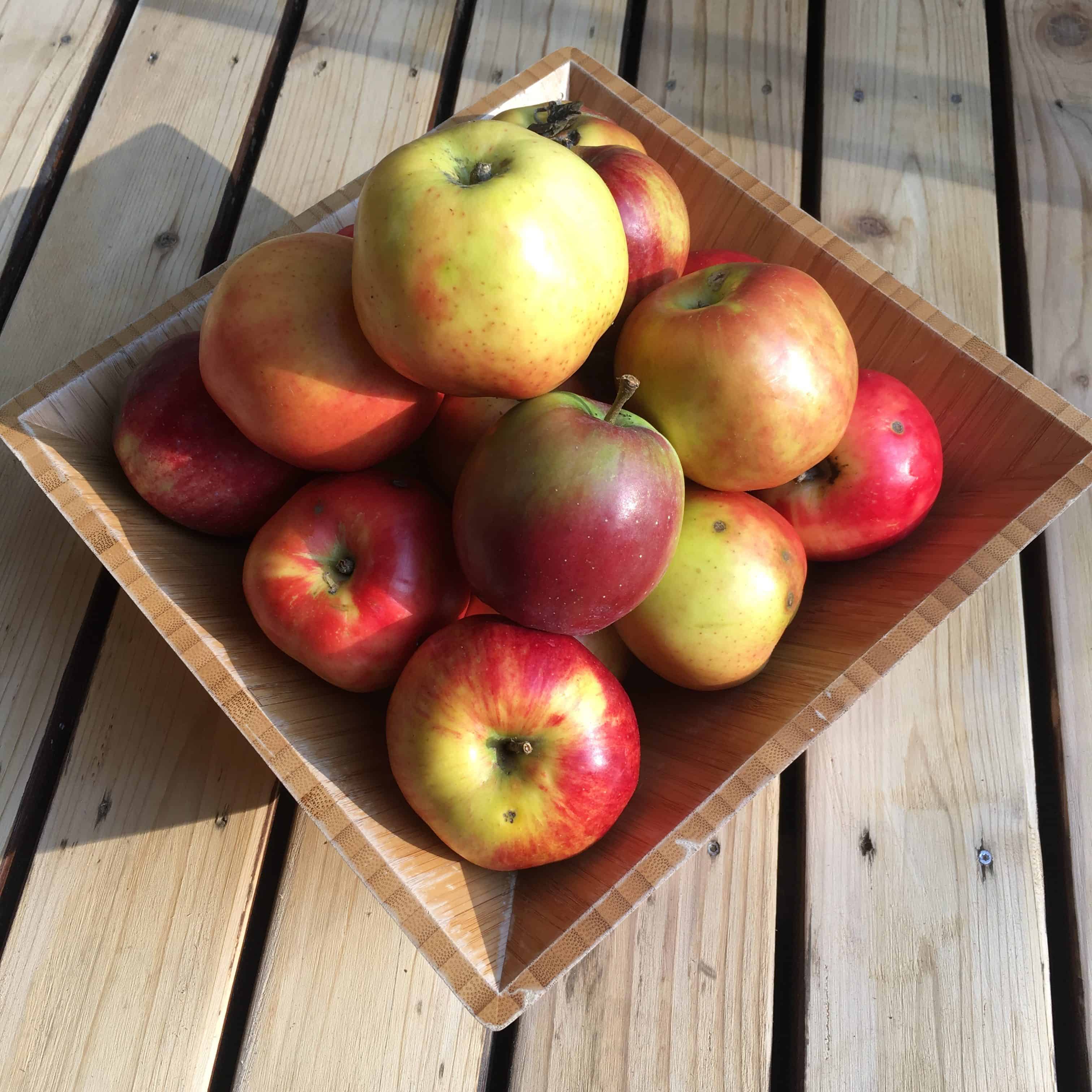Apple Butter!

#VeganMoFo18 Day 7 – Apple Butter
Please note, this post is meant as an overview of canning apple butter and does not replace or represent itself to be an official guide for proper canning at home. It is important to consult safe canning resources, which are listed at the end of this post.
Now that you’ve conquered making applesauce, apple butter will be a breeze! Apple butter is, quite simply, highly spiced, sweet, thick, spreadable applesauce. Apples are full of pectin, a gelatinous polysaccharide that thickens in the presence of acid, sugar, and heat, allowing a spreadable jam without adding powdered pectin packets. The name might be confusing to vegan eaters—there’s no butter or dairy in apple butter—it’s totally plant-based! The term butter just refers to the spreadability, like soft dairy butter. You can make butters from other fruits as well, such as peach or pumpkin, but note pumpkin butter cannot be home canned to be shelf-stable, as the mixture is too dense to ensure adequate heating, so it must be refrigerated or frozen.

Stack of home canned apple butter
I use a recipe from the Ball® Fresh Preserving recipe database. It’s got great flavor and firms up wonderfully. I do make one deviation, in that I follow the tip at the bottom of the recipe about using brown sugar. However, as a zero-waste vegan, I don’t buy brown sugar in the infernal plastic bag, I make it from granulated sugar and molasses, which is what brown sugar is. Brown sugar can be made simply by mixing 1 cup granulated sugar with 1 Tablespoon molasses—really! So in this recipe, I used 3-3/4 cups of granulated sugar and 1/4 cup molasses in place of the sugar.
You start out just like applesauce. Peel (or not), pare, and core your apples. You’ll simmer them in a little bit of water until they are soft and then run through a food mill or food press to puree. Return the sauce to the pot, add sugar and seasonings (cinnamon and cloves), and then cook down until thick. Note, you’ll definitely want to put a splatter guard over your pot because this stuff will splatter, shooting boiling, sticky globs of molten applesauce that will cause bad burns and make a sticky mess all over your kitchen. You don’t want to keep the lid on because you need the steam to escape and allow the mixture to thicken. Stir frequently during this part, removing the splatter guard away from yourself and holding it to shield from splatters while you stir.

A splatter guard is really necessary when making apple butter
The recipe says to cook until the mixture mounds on a spoon. This can be confusing for people because it’s not really measurable, it’s more of a look and feeling, and a fairly old jellying term. It means that when you scoop the mixture up with a spoon, it fairly holds its own shape, higher in the middle and sloping down to the edges of the spoon, rather than being a liquid that pours off to be level with the edges of the bowl of the spoon. I like to get a spoonful and set it on a trivet or plate to cool to see what the cooled consistency is, that works the best for me, as the mounding business is just a bit too subjective for me. The final consistency of the canned apple butter will be firmer than the cooled spoon.

Cooked down apple butter
When you reach your desired consistency, can as you did applesauce. Use times listed in the recipe, adjusting for altitude, if applicable.
Resources
There are some great resources available for home canning. Internet resources are fantastic as they are generally most up to date. There are some standby books, but remember to get new ones every few years to be current with updated guidelines.
Ball® Blue Book® Guide to Preserving
National Center for Home Food Preservation
Washington State University Extension Food Preservation
Iowa State University Preserve the Taste of Summer Online Canning Class
Ball® and Kerr® Fresh Preserving Website
My Vegan and Whole Food Plant-Based Canning Facebook Group
I do hope you try making apple butter. It is very delicious and makes wonderful gifts. Use it on toast or as a filling in an autumn cake. And it’s amazing, no trimazing, on pancakes!

Apple butter on toast
Do you like this post? Please share....
[mashshare]
If you liked this post, you might like one of these:

[Trī-māz-ing]
Cindy wants you to be Trimazing—three times better than amazing! After improving her health and fitness through plant-based nutrition, losing 60 pounds and becoming an adult-onset athlete, she retired from her 20-year firefighting career to help people just like you. She works with people and organizations so they can reach their health and wellness goals.
Cindy Thompson is a national board-certified Health and Wellness Coach, Lifestyle Medicine Coach, Master Vegan Lifestyle Coach and Educator, Fitness Nutrition Specialist, Behavior Change Specialist, and Fit2Thrive Firefighter Peer Fitness Trainer. She is a Food for Life Instructor with the Physicians Committee for Responsible Medicine, Rouxbe Plant-Based Professional, and Harvard Medical School Culinary Coach, teaching people how to prepare delicious, satisfying, and health-promoting meals.
She provides health and lifestyle coaching at Trimazing! Health & Lifestyle Coaching. Cindy can be reached at info@trimazing.com.
Subscribe to the Trimazing Blog
Receive occasional blog posts in your email inbox.
Subscribe to the Trimazing Blog
Receive occasional blog posts in your email inbox.




















